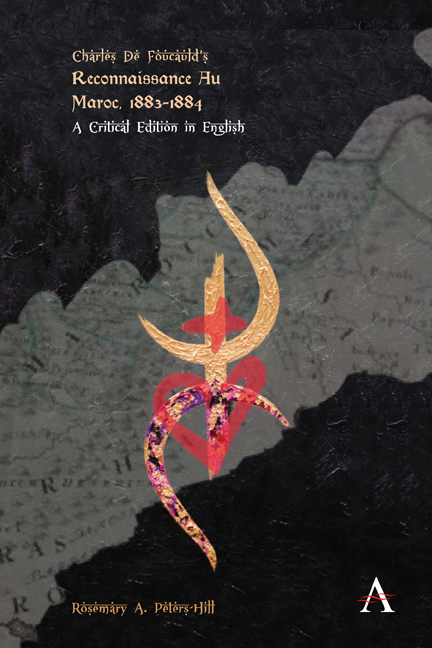Book contents
- Frontmatter
- Contents
- List of Figures
- Acknowledgments
- “There are no roads”: Charles de Foucauld’s Reconnaissance au Maroc—a Critical Introduction
- Charles de Foucauld, Reconnaissance au Maroc, 1883–1884
- Letter to François de Bondy
- Introduction
- Avant-Propos
- I Tangiers to Meknès
- II Meknès to Qaçba Beni Mellal
- III Qaçba Beni Mellal to Tikirt
- IV Tikirt to Tissint
- V Sojourn in the Sahara
- VI Tissint to Mogador
- VII Mogador to Tissint
- VIII Tissint to the Dadès
- IX The Dadès to Qçabi ech Cheurfa
- X Qçabi ech Chorfa to Lalla Maghnia
- Appendix: The Jews of Morocco
- Note on the Materials Used to Draw Up My Itinerary
- Report Delivered to the Société de Géographie de Paris in Its General Session of 24 April 1885
- “Itineraries in Morocco”
- Afterwards: An Afterword
- Glossary of Terms
- Bibliography
- Index
IX - The Dadès to Qçabi ech Cheurfa
Published online by Cambridge University Press: 20 January 2022
- Frontmatter
- Contents
- List of Figures
- Acknowledgments
- “There are no roads”: Charles de Foucauld’s Reconnaissance au Maroc—a Critical Introduction
- Charles de Foucauld, Reconnaissance au Maroc, 1883–1884
- Letter to François de Bondy
- Introduction
- Avant-Propos
- I Tangiers to Meknès
- II Meknès to Qaçba Beni Mellal
- III Qaçba Beni Mellal to Tikirt
- IV Tikirt to Tissint
- V Sojourn in the Sahara
- VI Tissint to Mogador
- VII Mogador to Tissint
- VIII Tissint to the Dadès
- IX The Dadès to Qçabi ech Cheurfa
- X Qçabi ech Chorfa to Lalla Maghnia
- Appendix: The Jews of Morocco
- Note on the Materials Used to Draw Up My Itinerary
- Report Delivered to the Société de Géographie de Paris in Its General Session of 24 April 1885
- “Itineraries in Morocco”
- Afterwards: An Afterword
- Glossary of Terms
- Bibliography
- Index
Summary
The Dadès to the Qçar es Souq
25 April. Departure at five o’clock in the morning. My Seddrâti, accompanied by a second rifle, escorts me. I leave the Oued Dadès behind. Above Aït Iidir, we can see that its valley stays the same for four or five kilometers, then narrows: the plain that stretched out to its left ends and a high embankment replaces it; the river, without losing its embellishment of greenery, enters a narrow pass where we lose sight of it. It dives into the High Atlas. I move onto the low, level plateau bordering it to the east. A change in the terrain is most astonishing: the plateau I am entering is the western extremity of an immense plain which, beginning east of the Oued Ziz, even east of the Oued Gir, stretches out to the west as far as the Oued Dadès. This large depression separates the High Atlas and Anti-Atlas ranges, and sinks down between them like a deep gulf. Having ventured into this plain, I will keep traveling here until I reach the Ziz. In this whole region, it divides into two sections that we might call upper and lower: the first, where I walk currently and which I will cross (1) from here to Imiter and (2) from the Gheris to Qçar es Souq, is the primitive portion of the plain; it extends along the whole High Atlas and has as its borders: north, the High Atlas range; west, the Oued Dadès; south, the Anti-Atlas from the Dadès to Imiter, and beyond that the lower section. That section, which I will enter in Imiter and remain in until the Gheris, runs along the foot of the Anti-Atlas and its boundaries are marked out: south, by that range; west and north, by the upper section. The second section is below the first and separated from it along its entire length by a uniform bank. This bank is like a step placed between the two floors of the plain, and the same all over: about 100 meters high, composed of pink rock, and the diagram shows its shape: sheer at the summit and gently sloped at the foot.
- Type
- Chapter
- Information
- Charles de Foucauld’s Reconnaissance au Maroc, 1883–1884A Critical Edition in English, pp. 333 - 352Publisher: Anthem PressPrint publication year: 2020



